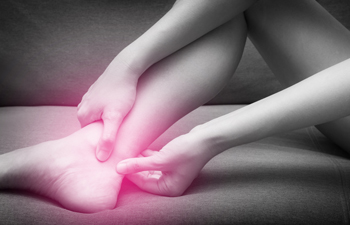 The medical condition that is referred to as Achilles tendinopathy is a type of Achilles tendon injury. The Achilles tendon is located in the calf, and connects the heel bone to the calf muscles. The common cause of this type of injury is overuse, and it can occur in patients who are not involved in sporting activities. Additional causes of Achilles tendinopathy include arthritis, wearing shoes that do not fit correctly, or taking specific types of antibiotics. Common symptoms that are often associated with this ailment can consist of swelling, pain in the back of the heel, and difficulty walking. Relief may be found when the activity that caused the injury is temporarily stopped, and it may be beneficial to engage in physical therapy, or to wear shoe inserts. If you have pain in the back of your heel, it is suggested that you consult with a podiatrist who can help you get proper treatment.
The medical condition that is referred to as Achilles tendinopathy is a type of Achilles tendon injury. The Achilles tendon is located in the calf, and connects the heel bone to the calf muscles. The common cause of this type of injury is overuse, and it can occur in patients who are not involved in sporting activities. Additional causes of Achilles tendinopathy include arthritis, wearing shoes that do not fit correctly, or taking specific types of antibiotics. Common symptoms that are often associated with this ailment can consist of swelling, pain in the back of the heel, and difficulty walking. Relief may be found when the activity that caused the injury is temporarily stopped, and it may be beneficial to engage in physical therapy, or to wear shoe inserts. If you have pain in the back of your heel, it is suggested that you consult with a podiatrist who can help you get proper treatment.
Achilles tendon injuries need immediate attention to avoid future complications. If you have any concerns, contact one of our podiatrists of APEX Foot & Ankle Center. Our doctors can provide the care you need to keep you pain-free and on your feet.
What Is the Achilles Tendon?
The Achilles tendon is a tendon that connects the lower leg muscles and calf to the heel of the foot. It is the strongest tendon in the human body and is essential for making movement possible. Because this tendon is such an integral part of the body, any injuries to it can create immense difficulties and should immediately be presented to a doctor.
What Are the Symptoms of an Achilles Tendon Injury?
There are various types of injuries that can affect the Achilles tendon. The two most common injuries are Achilles tendinitis and ruptures of the tendon.
Achilles Tendinitis Symptoms
- Inflammation
- Dull to severe pain
- Increased blood flow to the tendon
- Thickening of the tendon
Rupture Symptoms
- Extreme pain and swelling in the foot
- Total immobility
Treatment and Prevention
Achilles tendon injuries are diagnosed by a thorough physical evaluation, which can include an MRI. Treatment involves rest, physical therapy, and in some cases, surgery. However, various preventative measures can be taken to avoid these injuries, such as:
- Thorough stretching of the tendon before and after exercise
- Strengthening exercises like calf raises, squats, leg curls, leg extensions, leg raises, lunges, and leg presses
If you have any questions please feel free to contact our offices located in Fort Myers, Cypress Cove, Shellpoint, Naples, and Carlisle, FL . We offer the newest diagnostic tools and technology to treat your foot and ankle needs.